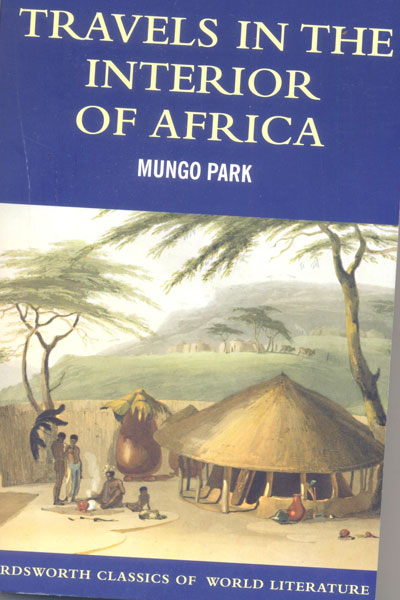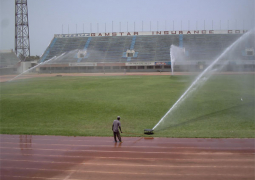Literature, 2005,390 pages.
First Impressions on The Gambia of 1795
This book is one of the most popular travel literatures ever written by any of the early European explorers of Africa. It should be of interest to Gambian readers because MungoPark devotes a respectable chunk of the book on his experiences traveling through the river Gambia on his way to discover the source of the River Niger in 1795. He gives a good account of the customs, religion, food, and clothing. mores, economic activities of the peoples living along the banks of the river; this is why, parts of his account are more anthropological than a simple travelogue.
The source of the mighty Niger River which runs through Nigeria, Niger, Mali had for long exercised the minds of geographers and European adventurers. It was reputed as a lucrative trade artery whose control would yield hefty profits. As the British in particular were quite averse to annexing any African territory without first confirming their trade potentials, the Royal African Society was encouraged to gather as much data on the regions along the Niger as possible. Accordingly, MungoPark, a 29 year old surgeon was sent out in middle of 1795 to find the source of the Niger and map out some of the trade potentials that inhered in the regions below and above the river. The mission was justified in many ways by its sponsors the Royal African Society: firstly, Park will provide a detail eyewitness account of the extent of the slave trade in this part of Africa which information was to be useful to the Abolitionists' struggle; second, his notes would update British knowledge of the geography of this part of Africa which was still based on Leo Africanus' travelogue Description of Africa published in 1526. British knowledge of western Africa was still very exiguous which was why Park's mission had in it some urgency. In those days of imperial expansion, knowledge of geography was an important tool for the armies of imperial conquest. Finally, as all the previous explorers sent out by the society such as Houghton had died before getting far into western AfricaPark's mission had an added significance to it.
On May 22 1795, Park set out from Liverpool aboard a merchant ship destined for Gambia called the Endeavour. On 21 June 1795. The ship anchored at Juffureh (page 3) in the Gambia. his first impressions were of a country rich in food and salt products: 'The kingdom of Barra, in which the town of (Juffureh) is situated, produces great plenty of the necessities of life: but the chief trade of the inhabitants is in salt: which commodity they carry up the river in canoes as high as Barraconda, bringing down in return Indian corn, cotton, clothes, elephant teeth and small quantities of gold dust. The number of people and canoes constantly employed in this trade makes the king of Barra more formidable to Europeans than any other chieftain on the river which encouraged him to charge entry duty of 20 pounds on every vessel, great and small'. We see in this description that Gambian political entities such as the BarraKingdom were indeed flourishing economically and politically before the European intrusion in the 19th century; the glowing trade described above could only be possible in a politically stable entity.
Park's description of other liver towns such as Bintang (page 4). Jonkakunda etc were also revealing of the state of abundance, tranquility of the areas along the river Gambia. Indeed, as he progresses the river towards the east, his impressions seems to be getting more positive. When he fell sick of malaria, he was nursed back to life by a hospital Gambian signara (mulatto), a poignant reminder that Gambian hospitality has a long story behind it. His description of a posse of Serahuli merchants he met in Wuli (page 57) is also telling of the long history of entrepreneurship of this section of Gambian community.
However, he also writes about the more insalubrious aspects of the society in the close of the 18th century: the slave trade. Park describes the horrors and terror of the slave caravans he met marching towards the sea to the awaiting ships at Bintang or JamesIsland. His heart rending descriptions of the wretchedness of the slaves, their torture, hunger and death must have been timely fodder for the cannon of the Abolitionists back home.
A female slave who was part of a slave coffle Park was traveling with had fallen ill and was unable to move on any more: 'At day break poor Neele was awakened, but her limbs were now become so stiff and painful that she could neither walk nor stand.. .Every attempt to carry her forward being thus found ineffectual, the general cry of the coffee was. Kang tei, kang tei 'cut her throat, cut her throat' (page 310). She was slaughtered and her clothes given to one of the slave overseers as a present.
This book therefore offers an incisive insight into the state of the Gambia two hundred years ago. Park was a keen albeit fleeting observer, whose accounts tell the story of a Gambian society that was at peace with itself, flourishing and sanguine before the rude awakening of European colonial penetration in the first quarter of the 19th century which ably destroyed much of this glory.
Of all the numerous explorers who passed through the Gambia, Park stands out not the least because he visited twice in 1795 and 1805, but also because in his memory an obelisk was erected at Karantaba in Sami in 1944 to mark his point of departure in his ill fated attempts to find the source of the river Niger.
It is highly recommended for readers interested in life in the Gambia at the end of the 18th century.
The Book is available at Timhooktoo, 4494345



